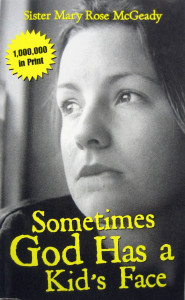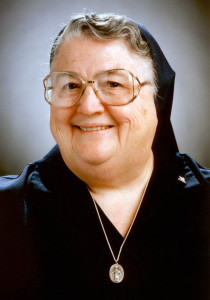by Father Robert Lauder
A few days ago, I found in my room a copy of the small book, Sometimes God Has a Kid’s Face (Covenant House, 2010, pp. 111), written by Sister Mary Rose McGeady, D.C.
I was trying to clean my room just a little bit and I found the book amidst some papers. Perhaps it had been sent to me by Covenant House because of a small donation that I made. Though I am not certain how I obtained a copy of Sister Rose’s book, which has over 1,000,000 copies in existence, it may have been providential that I found it.
The book is only 111 pages but it is a beautiful testimony to the work that Covenant House does with teenagers. The story of teenagers who have been helped at Covenant House is a marvelous story and Sister Rose tells it beautifully.
The following is on the back cover of Sometimes God Has a Kid’s Face:
“They are like shadows in our cities, small outlines of skin and bones that attach themselves to abandoned buildings, park benches, narrow alleyways. And when darkness falls, these shadows disappear into places many of us will never, ever see in this lifetime. Very few people know the faces of these shadows, or their names. They are America’s untouchables and unreachables – America’s street children.”
A Holy Tornado
In the Introduction to the book, Kevin Ryan, the current president of Covenant House, has written the following about Sister Rose, who died in September, 2012, at the age of 84:
“Sister Mary Rose was the Mother Teresa of street children, a holy tornado of determination and compassion. She lived and died every day with the successes and failures of our kids … and she saw God in the tired faces of beautiful, frightened kids.
“In her 13 years as Covenant House president, Sister Mary Rose expanded the reach of our work dramatically. She established new crisis shelters, street outreach, and long-term residential houses for homeless youth in Canada, the United States and Nicaragua, doubling the number of children being served by Covenant House annually.” (p. 5)
In her book, Sister Rose brings me into another world. It is a world of homeless teenagers, overlooked or forgotten by many. It is a world I have never experienced directly, but because of Sister Rose’s commitment and faith, it is a world that I can now recognize. What Sister Rose has done in this small gem of a book is shed the light of her faith on homeless teenagers. Sister Rose’s faith saw these kids in the most profound way possible – as infinitely loved by God.
What makes this small book such valuable reading is first, the stories that Sister Rose has heard from the teenagers, and that she relates to us, the readers. Second is the faith vision that Sister Rose presents to us, the readers. Some of the stories are hair-raising. Reading them was a revelation to me. Since going through the book, I have spoken to others who have worked with homeless teenagers and one of the words that kept emerging in the conversation was “predators.”
Apparently, there are some very unattractive people who know how to manipulate these kids and use them for their own monetary gain. One of the main ways that the kids are used is for prostitution. If anyone was looking for an image of evil in the contemporary world, the image of people pushing kids into prostitution would be one of the most powerful.
Seeing the Face of God
But even more than the stories that Sister Rose relates, the power of the book, for me, was expressed in the title. The title, when I first read it, reminded me of the famous line from the musical Les Miserables that has been quoted in many homilies: “To love another person is to see the face of God.”
More than the line from the musical, the title calls our attention to some of the most important truths of the Christian faith. God is infinitely in love with the homeless teenagers. Though they may have a difficult time believing in their value and dignity, Sister Rose was like a messenger from God, sent to convince those kids of God’s love. It is as though each homeless teenager wears a sign which reads: “Son of God died for me.”
 Sister Rose prefaces several chapters in the book with statements that kids have written in the Covenant House Chapel. The following is typical of what many of the teenagers write:
Sister Rose prefaces several chapters in the book with statements that kids have written in the Covenant House Chapel. The following is typical of what many of the teenagers write:
“Dear God,
I just want someone to love me, someone to talk to when I need to talk. Someone to cry on when I need to cry. Most of all someone to love me and walk as far as they wish through my life. Amen.” (p. 32)
There are many inspiring signs of goodness in the contemporary world. Covenant House is one of them.
